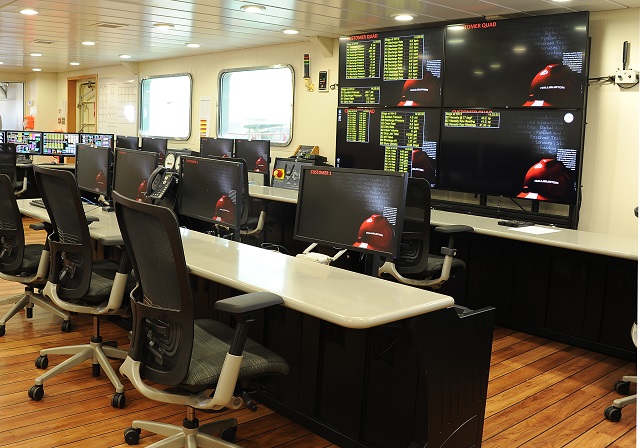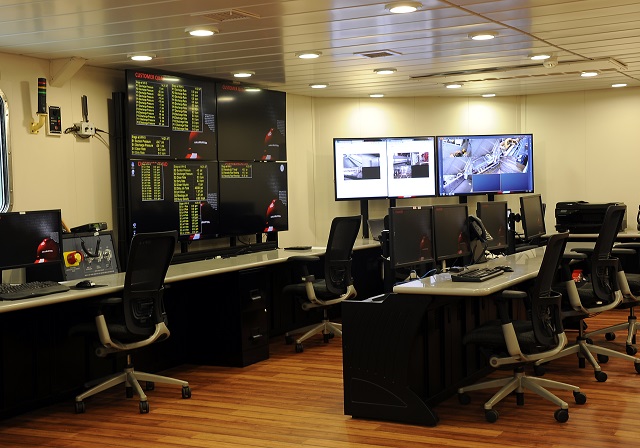Halliburton: The Importance of Control Room Design
Hydraulic well fracturing is no small feat. It is undertaken using massive boats called simulation vessels. These colossal ships measure hundreds of feet in length and carry millions of pounds of equipment, sand, water and chemicals used to crack through oceanic rock containing precious oil and gas.
Often located off the U.S. Gulf Coast, South America, and various other locations around the world, engineers, equipment operators, technology workers, data analysts and others perform the precision hydraulic fracturing and sand control operations that take anywhere from one day to a few weeks to complete.
Known the world over as one of the largest providers of products and services to the energy industry, Halliburton works with shipbuilders to produce one to two hydraulic fracturing boats a year, depending on the number of contracts from oil and gas producers.
“A key element in the boat design is the control room,” said Kenny McConnell, tech services specialist with Halliburton, which is headquartered in Houston and Dubai. “We control all of the equipment and the entire job from the control room.”
.jpg) Space limitations
Space limitations
One of the challenges designers face when building out a control room in a new simulation vessel is working within the confines of the ship design.
“The design of the ship is completed by a ship designer, so when we’re designing control rooms, we’re basically stuck with the room they provide,” McConnell said. “We take the hull design, and we can modify the deck to get our equipment on board, but the control room is built into the super structure of the ship. Whatever the shipbuilder puts into the design for the control room, that’s what we have to work with.”
Confronting the space challenges created a puzzle for McConnell and his design staff to include the required control room equipment and fit it all into the limited, pre-designed space. As well as fit, making the best use of the space to ensure ergonomic and comfortable workstations as well as creating a smooth workflow environment wasn’t an easy task.
“We’re controlling all the equipment on the deck from this room and the first thing I consider is how much space I have and the number of workstations that need to get into that space,” McConnell said. "Then I need to find furniture that is functional for the workflow and takes ergonomics into consideration. Our clients from the oil companies are with us throughout the entirety of each job, so the control room also needs to be very professional looking. ”
Working with Winsted Corporation, a Minneapolis-based manufacturer of technical consoles and control room furniture, McConnell selected a console configuration specifically designed to save space and maximize control room functionality. Called Insight consoles, which is part of Winsted’s Prestige line of control room furniture, the workstations gave Halliburton’s command center ergonomic consoles with ample work areas and desktop space.
“Winsted’s consoles and furniture class were easy to work with, and their design package worked really well with our control room layout,” McConnell said.
 Custom video wall solutions
Custom video wall solutions
While designing the control room with the consoles proved easy for Halliburton’s design team, one challenge in the layout called for custom furniture solutions. A standard video wall simply wouldn’t fit correctly in the available space. McConnell and his team were forced to seek other options.
“We had a video wall in our control room design, which was a freestanding wall that sat behind the consoles,” McConnell said. “That would have been fine if we were in a control room that was fixed and not inside a moving ship, and if we had space behind the consoles. We didn’t have either of those features with our limited space, so we had a challenge on our hands instead.”
In an attempt to position the video wall as close to the consoles as possible, McConnell considered various design scenarios using Winsted’s Equipment Layout Software (WELS), but came up empty. Soon the team decided the only option was a custom solution.
“I asked Winsted if they could modify the video wall design and mount it to the back of the consoles rather than the standard freestanding configuration,” McConnell said. “They were able to accommodate that request and redesigned the wall – it all turned out fantastic.”
The video wall McConnell and his team selected is called the M-VIEW, which is an extruded aluminum monitor wall that is flexible, expandable and offers modular functionality. The structure can support any size flat-panel monitor, and be configured as an in-line, concave or convex mounting solution, which gave Halliburton numerous options for configuring the wall, monitors and consoles within the control room.
 Successful control room operations
Successful control room operations
As well as consoles and custom video walls, the Halliburton team oversaw installation of the entire control room, which included a sophisticated computer system, communications system, video system, satellite systems and numerous other types of technology to help control the hydraulic fracturing equipment operating on-deck and monitor well conditions deep below the water’s surface.
“We normally have about five or six operations going on within the control room, so it’s a busy place,” McConnell said. “All the people who are controlling the equipment on-deck, the engineers, the data techs and even our clients are impressed with the space.”
As clients spend a great deal of time in the control room, the importance of maintaining highly functional operations is paramount for Halliburton. Fortunately, the company’s hydraulic fracturing operations meet these standards in the control room and beyond.
“Everybody loves the look and functionality of the control room,” McConnell said. “Everyone who comes into the room takes a step back and says ‘wow.’ Then they start bringing in other people to see the room and show it off. That makes me feel good. Our control rooms truly are a showpiece for the boat.”
The opinions expressed herein are the author's and not necessarily those of The Maritime Executive.
